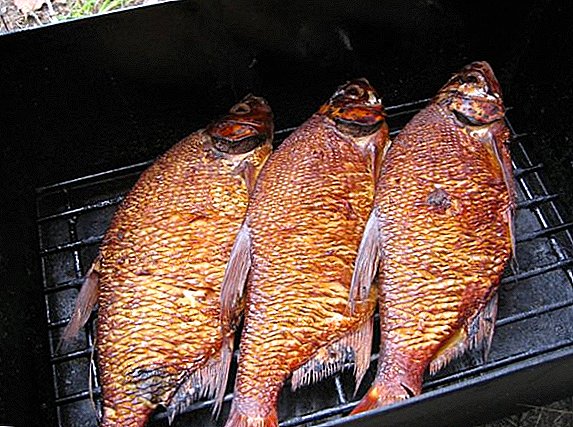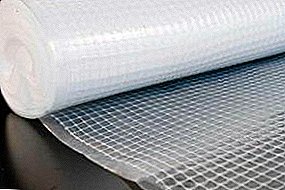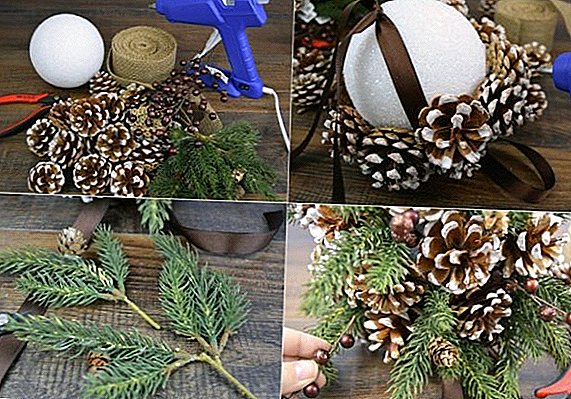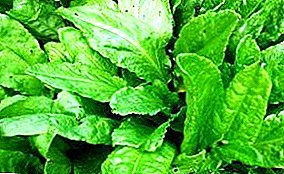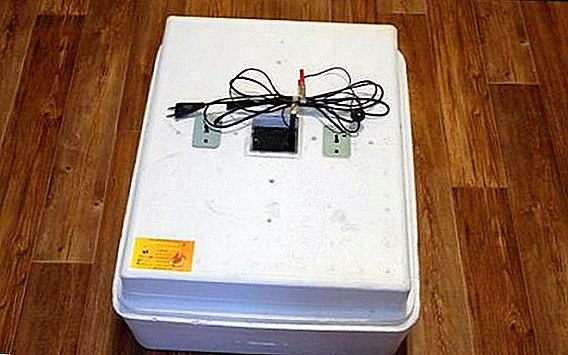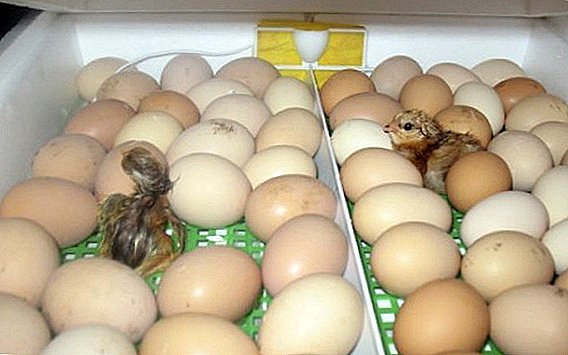 Practically every poultry farmer knows about the need for pre-incubation egg storage. This process is necessary in order to collect a sufficient amount of incubation material. After all, in small batches to place it in an incubator is not at all profitable. Yes, and some experts say that the percentage of hatchability of chicks increases, if the eggs get into the incubator a few days after the demolition. Therefore, it is useful to know the details of the storage of the material before it is placed in the incubator.
Practically every poultry farmer knows about the need for pre-incubation egg storage. This process is necessary in order to collect a sufficient amount of incubation material. After all, in small batches to place it in an incubator is not at all profitable. Yes, and some experts say that the percentage of hatchability of chicks increases, if the eggs get into the incubator a few days after the demolition. Therefore, it is useful to know the details of the storage of the material before it is placed in the incubator.
Which eggs are suitable for incubation
Nestlings are not born from all eggs. In order not to fail and send a non-viable product for incubation, it is necessary to become familiar with the selection rules for the incubation material.  First you need to sort the material and select the appropriate size. Ideal for laying in the incubator is considered to be chicken eggs weighing 52-65 g, duck and turkey - 75-95 g, goose - 120-200 g, guinea fowl - 38-50 g, quail - 10-14 g, ostrich - 1300-1700 No less important form.
First you need to sort the material and select the appropriate size. Ideal for laying in the incubator is considered to be chicken eggs weighing 52-65 g, duck and turkey - 75-95 g, goose - 120-200 g, guinea fowl - 38-50 g, quail - 10-14 g, ostrich - 1300-1700 No less important form.
Did you know? The largest egg laid chicken in the Grodno region in Belarus. It weighed 160 g.
Round, strongly elongated, oblate and tapered are not suitable for incubation.
Sorting eggs by size and shape, you need to check the condition of the shell. It should be flat and smooth. Bumps, roughness, cracks, scratches, thinning / thickening, growths, stains and dirt are unacceptable.
If no external defects are found, proceed to check the contents. For this, they use ovoscopes. The lumen clearly shows the state of the yolk, white, and the location of the air chamber.
Learn how to properly ovoskopirovat eggs before laying in the incubator and whether you can make an ovoskop with your own hands.
Normally, the yolk is located in the center, with a slight shift to a blunt end. Its consistency is uniform, without inclusions, stains. Color - deep yellow. If the egg in a horizontal position is rotated, then the yolk will deviate slightly in the direction of rotation (it does not touch the shell) and will again take up its original position. Protein must be viscous.  Ovoscopic eggs The air chamber is located at the blunt end and has clear boundaries. A slight deviation to the side is permissible. Normal dimensions of the chamber: diameter - up to 15 mm, thickness - up to 2 mm. When rotating, the camera should not change its position.
Ovoscopic eggs The air chamber is located at the blunt end and has clear boundaries. A slight deviation to the side is permissible. Normal dimensions of the chamber: diameter - up to 15 mm, thickness - up to 2 mm. When rotating, the camera should not change its position.
Reject need eggs:
- with two yolks;
- with mixed protein and yolk (homogeneous in the lumen);
- with blood clots and blood belt;
- with dark spots;
- with the yolk stuck to the shell.
Learn how to choose high-quality eggs for incubation.
Shelf life
Only fresh eggs are suitable for incubation. They have the highest rates of hatchling chicks. Therefore, it is very important how much the product is stored before incubation. 
Guaranteed
Optimum shelf life (days):
- chickens - up to 5-6;
- goose - up to 10-12;
- ducks - up to 8-10;
- guinea fowl - up to 8;
- quail - up to 5-7;
- turkey - up to 5-6;
- Ostrich - up to 7.
Important! At such storage times, the birth rate of chickens is the highest. Each subsequent day reduces the viability of the embryo by 1%.
Maximum shelf life
It is not always possible to place the eggs in the incubator on time. Therefore, it is necessary to know how long after the warranty period of storage the embryo remains viable. On average, it can be saved up to 15-20 days. But this is possible only under certain conditions: periodic heating of the incubation material or storing it in an ozonized room. 
How to store the hatching egg: the necessary conditions
The main thing, when storing the incubation material, is to maintain the temperature and humidity of the air at a certain point. For each species, these indicators are individual:
- chicken: temperature - + 8-12 ° С, humidity - 75-80%;
- goose: temperature - + 12-15 ° С, humidity - 78-80%;
- duck: temperature - + 15-18 ° С, humidity - 78-80%;
- guinea fowl: temperature - + 8-12 ° С, humidity - 80-85%;
- quail: temperature - + 12-13 ° С, humidity - 60-80%;
- turkey: temperature - + 15-18 ° С, humidity - 75-80%;
- Ostrich: temperature - + 16-18 ° С, humidity - 75-80%.
As you can see, the average optimal storage temperature - 8-12 ° C, and humidity - 75-80%.
Did you know? The maximum number of yolks in an egg that has ever been encountered - nine.
The room where the eggs will be stored must be equipped with instrumentation (preferably not one). It must have good ventilation and clean air, since odors easily penetrate through the shell. Drafts are unacceptable, because they accelerate the process of evaporation of moisture from the surface of the shell.  Indoors it is best to install racks on which boxes with incubation material will be installed. It is advisable to break boxes into cells using thin plates or cardboard. The size of the cell must match the size of the egg. Can be used to store cardboard pallets in which the product is sold in stores.
Indoors it is best to install racks on which boxes with incubation material will be installed. It is advisable to break boxes into cells using thin plates or cardboard. The size of the cell must match the size of the egg. Can be used to store cardboard pallets in which the product is sold in stores.
Read about incubation of chicken, turkey, duck, goose eggs.
In the cells of the incubation material should be placed with a sharp end up or horizontally.
With long-term storage you need:
- warm the incubation material every 5 days for 5 hours, return to normal conditions after warming up;
- place the product in a polyethylene filled with nitrogen;
- install an ozonizer in the storage and maintain the ozone concentration at the level of 2-3 mg per cubic meter.
Important! In the process of long-term storage of eggs should be periodically rotated so that the yolk does not stick to the shell.
Can I keep my hatching egg in the fridge
It is possible to store in the refrigerator only when you have the opportunity to create the following conditions:
- temperature - not below + 8 ° С;
- humidity - not less than 75%, but not more than 85%;
- good ventilation.
 It is impossible to store an incubation egg in a refrigerator without proper conditions. From the above we can conclude that the incubation process should be started as soon as possible, since long-term storage harms the embryo. Even if the chicken could be born after a long pre-incubation period, there is no guarantee that he will not have developmental disabilities, health problems and he will be able to turn into an adult bird.
It is impossible to store an incubation egg in a refrigerator without proper conditions. From the above we can conclude that the incubation process should be started as soon as possible, since long-term storage harms the embryo. Even if the chicken could be born after a long pre-incubation period, there is no guarantee that he will not have developmental disabilities, health problems and he will be able to turn into an adult bird.
Video: Storage of hatching eggs
Reviews



